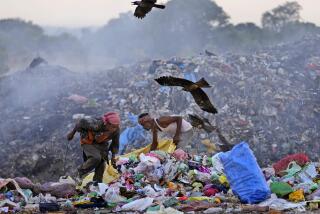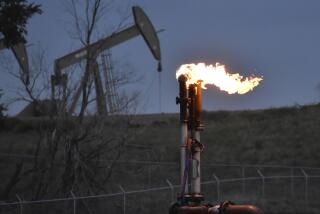Satellite data find landfills are methane ‘super emitters’

- Share via
BENGALURU, India — Landfills are releasing large amounts of planet-warming methane gas into the atmosphere from the decomposition of waste and are a significant contributor to such emissions in urban areas, a study suggests.
Scientists used satellite data from Delhi and Mumbai in India, Lahore in Pakistan and Buenos Aires in Argentina and identified specific locations in each city that persistently emit high methane levels, all of which were landfills. The cities’ overall methane emissions from all sources were 1.4 to 2.6 times higher than previous estimates.
The study, published in Science Advances on Wednesday, is aimed at helping local governments carry out targeted efforts to limit global warming by pinpointing specific sites of major concern.
When organic waste like food, wood or paper decomposes, it emits methane into the air. Landfills are the third-largest source of methane emissions globally, after oil and gas systems and agriculture.
Although methane only accounts for about 11% of greenhouse gas emissions and lasts about a dozen years in the air, it traps 80 times more heat in the atmosphere than carbon dioxide does. Scientists estimate that at least 25% of today’s warming is driven by methane from human actions.
“This is the first time that high-resolution satellite images have been used to observe landfills and calculate their methane emissions,” said Joannes Maasakkers, lead author of the study and atmospheric scientist at the Netherlands Institute for Space Research.
“We found that these landfills, which are relatively small compared to city sizes, are responsible for a large fraction of total emissions from a given area,” he said.
Satellite data to detect emissions is still a relatively new field, but it’s being used more and more to observe gases across the world. It means more independent organizations are tracking greenhouse gases and identifying big emitters, whereas previously local government figures were the only source available.
“This new work shows just how important it is to manage landfills better, especially in countries like India where landfills are often on fire, emitting a wide range of damaging pollutants,” said Euan Nisbet, an Earth scientist at Royal Holloway, University of London, who wasn’t part of the study.
Earlier this year, smoke hung over New Delhi for days after a massive landfill caught fire as the country was sweltering in an extreme heat wave with temperatures surpassing 122 Fahrenheit. At least two other landfill fires have been reported in India this year.
Nisbet added that the newer satellite technology, combined with on-the-ground measurements, makes it easier for researchers to identify “who is polluting the world.”
China and India are the world’s biggest methane polluters, a recent analysis by the International Energy Agency found.
At last year’s United Nations climate conference, 104 countries signed a pledge to reduce methane emissions by 30% by 2030 compared with 2020 levels. Both India and China are not signatories.
The authors plan to carry out more research into landfill sites across the world in future studies.
“It is a quickly developing field and we expect more interesting data to come out soon,” said Maasakkers.
More to Read
Sign up for Essential California
The most important California stories and recommendations in your inbox every morning.
You may occasionally receive promotional content from the Los Angeles Times.










